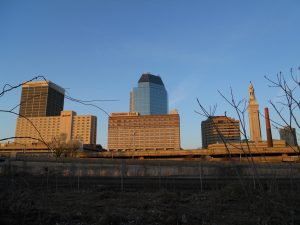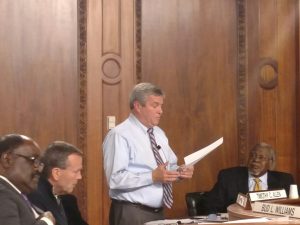In the Coming Year, Home is Where the Green Is in Springfield…
SPRINGFIELD—The City Council set the tax rates for the next year Monday night, rejecting Mayor Domenic Sarno’s recommendation and instead freezing residential rates at the current level. However, because the values of both residential and commercial property have risen, bills on both are likely to go up.
The decision to maintain the current residential rate and increasing values resulted in a jump in the commercial rate by 47 cents per thousand dollars in value. However, councilors chose this path to cushion the impact on homeowners as residences increased in value at a far faster clip than commercial property.
The final vote set the residential rates at $19.66 per $1000 in value and the commercial rates at $39.07 per $1000 in value—or 1.966% and 3.907% on total value respectively. The rates passed on a 9-3 vote with at-large councilor Thomas Ashe absent.
Sarno had recommend rates that were a nickel higher for residences and 13 cents less for commercial properties. The rates the Council approved were those recommended by a study group Ward 7 Councilor Timothy Allen, the chair of the Council Finance Committee, had assembled.
The study group, consisting of Allen, Greater Springfield Chamber of Commerce Nancy Creed, Chairman of the Board of Assessors Richard Allen, Springfield realtor Wilfredo Lopez and Springfield College economics professor Mark Howard, recommended the $19.66 rate on a 3-2 vote. Richard Allen and Creed supported the mayor’s rates.

Nancy Creed, President Springfield Regional Chamber of Commerce (via Linked In)
Before the Council set the rate, Creed argued in favor of the mayor’s recommendation, and would send a better signal to the business community, although it raised the rate on businesses 34 cents.
But Allen said rates were destined to rise for both regardless. “There’s no way to do this without both sectors of the city get a hit,” he said. Instead, he urged his colleagues to accept the study group’s suggestion so homeowners only paid more in taxes because their properties rose in value.
Richard Allen said under the Council’s rates, homeowners would see their bills rise about $142 a year or $7 more than the mayor’s proposal. He declined to articulate an average commercial tax bill increase because commercial property values vary far more than residences do.
At-large Councilor Bud Williams asked about using funds from MGM to defray future tax increases. Chief Administrative and Financial Officer Timothy Plante said that would be a discussion for when the city begins receiving revenue upon the casino’s opening in 2018.
City officials confirmed to WMassP&I that MGM is paying regular commercial property taxes until the facility’s opening when a provision under Chapter 121A of state law will take effect. At that point, the casino will be removed from the tax rolls and instead MGM will make payments in lieu of taxes.

Councilor Marcus Williams (via Facebook/official)
The rates passed comfortably, but there was opposition. Williams, at-large councilor Timothy Rooke and Ward 5 Councilor Marcus Williams voted against them.
Marcus Williams, however, did not favor the mayor’s rates. He said he wished the residential rate was lower, noting the average homeowner has not had an effective break in taxes in years.
“Although [the Finance Committee’s recommendation] was lower, I voted no because I am discontented with both the Mayor’s and the Committee’s proposed residential rate,” he said in a message to WMassP&I. “I feel the tax burden should not fall on homeowners as heavy as it did tonight.”
Setting the rates is an annual exercise as Springfield, like many of the commonwealth’s cities, split the rate between commercial and residential properties.
For the last few years, slow growth in property values kept the city’s levy ceiling under Proposition 2 ½, denying the city its full annual increase in the levy and any increase due to new growth.

Cities like Springfield have sometimes struggled to avoid their levy ceilings of the challenges urban centers face. (including uncontested races) on record. (WMassP&I)
Proposition 2 ½, a 1980 law that capped property taxes in Massachusetts, restricts how much property tax revenue a municipality can collect. It sets a ceiling of 2.5% of the value of all taxable property in a municipality. Each year it can increase its levy limit by 2.5% plus the tax revenue from any new growth such as construction or other improvements. Those increases cannot surpass the levy ceiling.
This year, assessed property values rose fast enough such that the city enjoyed both its annual levy limit and new growth, narrowly missing the ceiling by less than $15,000. However, that growth in value between residential and commercial property was uneven, requiring an adjustment of the tax rates.
Overall, the value of taxable property in Springfield rose from $7.276 billion to $7.658. But of that $318 million increase, not even 17% came from increases in commercial property values. The increase in value was overwhelmingly driven by residences. Residential properties represented nearly 72% of all taxable property values in Springfield and the faster residential value increases nudged this up a bit further.
The overall increase in value means the city will collect $9.5 million more next year than it does now.
That said, the split rates distributes the tax levy differently. Under the rates set by the Council, 57.03% of property tax revenue will come from homeowners. The rest will come from commercial taxpayers.
Richard Allen, the chair of the Board of Assessors, told councilors that sales were strong with a number of single family homes clearing the $200,000 mark. Around 90% of single family homes were estimates to increase in value this year over last year. Many two and three family homes also experienced an increase in value Allen said.
